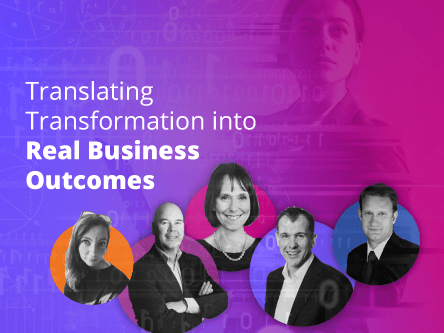I don’t think companies should have a digital strategy.
That’s not to say that a digital strategy is a bad thing – it often just doesn’t end up being executed on as it’s expected to.
Putting together an in-depth digital transformation roadmap or strategy might work great in one organisation, but not in another.
The main emphasis should be directed toward the broader business strategy. Then, you can look at how to execute on it, potentially involving digital tools or platforms. It’s crucial to understand that pursuing digital transformation without aligning it with the overarching business goals, will likely not lead to a successful outcome.
This is because the “digital” part of digital transformation is not actually the most important part. Yes, the tech plays a huge role in the success of any transformation, but the real test for success is the people behind it.
It’s no wonder that 70% of complex, large-scale change programmes fail, with the most common reasons being a lack of employee engagement, inadequate management support, poor or non-existent cross-functional collaboration, and a lack of accountability, according to McKinsey & Company.
The key to successful digital transformation is adapting the organisational culture, which can then steer towards using technology for the better. The focus must be on the wider business strategy and how digital capability can drive and enable that strategy, rather than going head-first with the technology itself.
Barriers to Transformation
Digital transformation can mean many different things for many different companies, depending on where they are on their digital journey.
It is a term so widely used, that the core meaning behind it can sometimes get lost.
Digital transformation does not need to refer to a complete overhaul of a business’ digital operations in favour of the latest up-and-coming technologies. This might be true for some businesses, but it can also be something as simple as training staff to move from Excel to a more advanced programme, or changing the company’s billing system to improve efficiency.
One of the most common mistakes when it comes to digital transformation is failing to think about the bigger picture.
For CTOs and CIOs, technology is at the forefront of their world, but that is not the case for the wider executive team. The majority of the C-suite are most invested in hitting the KPIs that directly align with the wider business strategy. They often simply do not have the time to fully immerse themselves into the technology side of the business, since that requires a lot of time and effort to ensure full understanding.
Change is often feared due to the unknown, and unless CTOs and CIOs can convince the C-suite that their digital transformation ideas fully align with the company’s vision and mission, they are setting themselves up for failure.
For digital transformation to succeed, it must align with this bigger picture, ensuring everyone can hit their targets and that success goes beyond just operational processes.
Small Changes, Big Differences
Another issue with a lot of digital transformation strategies is that they exist on paper, but don’t materialise.
This might be due to some of the challenges mentioned above, such as disagreements within the executive team, or the failure to convince the C-suite to allocate the time and resources required to make it a success.
While I have developed digital roadmaps in the past, I have come to believe that maintaining a separate digital strategy may no longer provide the same value. Instead, the focus should be on changing things “little and often”.
It’s much easier for CTOs and CIOs to gain approval for small technological changes within the business which can improve efficiency and productivity, rather than going to the C-suite with an overwhelming plan for future change.
Small changes can make big differences, and bit by bit, a company could be undergoing a full digital transformation without even realising it. Companies that see transformation as an ongoing process are much more likely to be successful, in comparison to companies that change too many things too quickly.
By approaching transformation incrementally, it also makes it easier to gradually build the right team culture to get behind the initiatives. For example, we could begin with a select group of supporters. Having one accountant who firmly believes in the change can motivate the entire accounting team. Next, select a specific business process where you can implement a change quickly. Scrum is a popular choice due to its ability to yield tangible results in a relatively short period.
In the end, we need to know that digital transformation is as much about the people as it is about the technology itself. The tech can only be successful if the team know how to use it to its full potential, and have the mindset and drive to want to do so.
It’s All About the People
It’s important to consider each and every member of the team that will be affected by the transformation, and ensure they feel supported along the way. It’s easy to tell the team that everyone needs to improve their digital skills for the company to transform its operations, but this might be much easier for one team member than another.
The crucial thing is making sure that everyone is improving, no matter what level they are at in a digital sense. There are many initiatives that can help the whole team get behind this idea, such as virtual training sessions, demos of new platforms or programmes, or even team away days to bring an element of fun into the training with a change of environment.
Another great way to ensure everyone feels supported during the change process is by allocating the right leadership positions across departments. It’s important to have people that can be involved with the digital transformation plans at a higher level, lead their respective teams through these changes, and monitor success. Employees usually respond better to change when they are supported by a familiar manager within their current team.
This is great for team morale across levels. Junior members of staff can get the support they need from a familiar face, without being worried to voice concerns or ask questions compared to if the management was coming from the very top level. At the same time, mid-level employees can gain further experience and responsibility for their own personal development, all while freeing up some time from senior executives who can focus on other aspects of the business instead.
Not everyone needs to progress or improve their digital skillset at the same pace, but everyone needs to improve little by little. That is when the real change will start to happen.
The evolution of the global business landscape never ends, and the same needs to be true for digital transformation in order to keep up in today’s fast-paced market. The organisations that view transformation as an ongoing journey, rather than a short-term goal, will be the ones that can truly transform their company culture and digital operations in the long-term.
Author: Aidan Hancock | CIO, Johnson Matthey
About Johnson Matthey
Johnson Matthey is a global leader in sustainable technologies. For over 200 years we’ve used advanced metals chemistry to tackle the world’s biggest challenges.
Many of the world’s leading energy, chemicals and automotive companies depend on our technology and expertise to decarbonise, reduce harmful emissions and improve their sustainability.
And now, as the world faces the challenges of climate change, energy supply and resource scarcity, we’re actively providing solutions for our customers. Through inspiring science and continued innovation, we’re catalysing the net zero transition for millions of people every day. For more information visit www.matthey.com.








